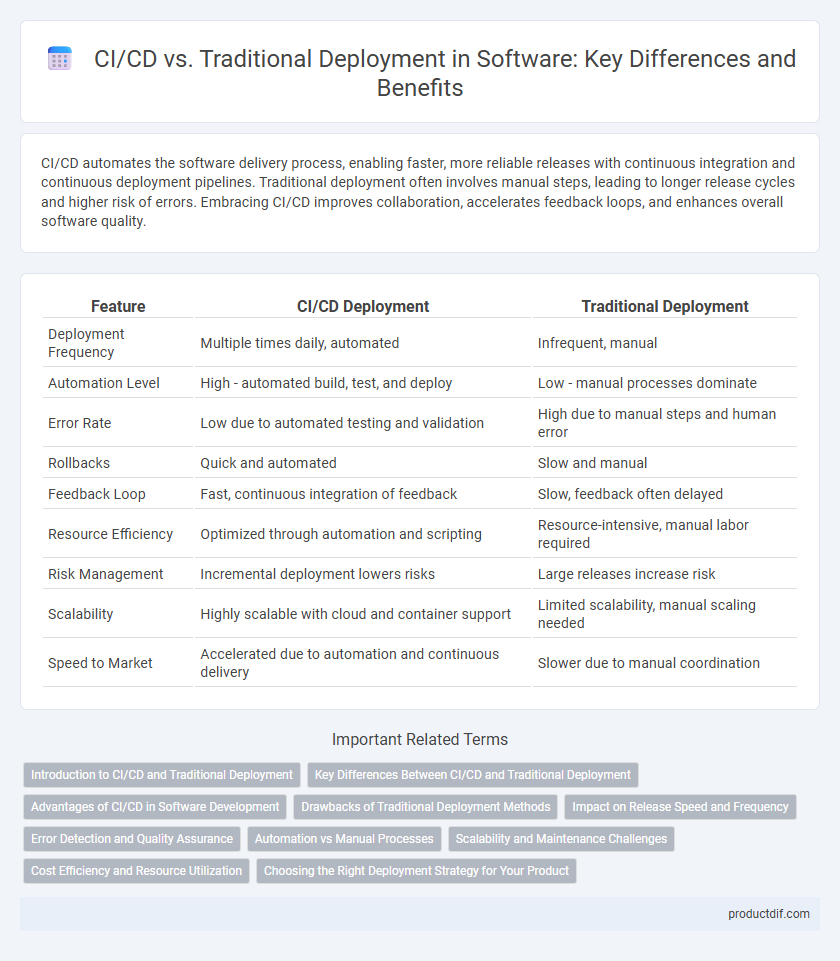CI/CD automates the software delivery process, enabling faster, more reliable releases with continuous integration and continuous deployment pipelines. Traditional deployment often involves manual steps, leading to longer release cycles and higher risk of errors. Embracing CI/CD improves collaboration, accelerates feedback loops, and enhances overall software quality.
Table of Comparison
| Feature | CI/CD Deployment | Traditional Deployment |
|---|---|---|
| Deployment Frequency | Multiple times daily, automated | Infrequent, manual |
| Automation Level | High - automated build, test, and deploy | Low - manual processes dominate |
| Error Rate | Low due to automated testing and validation | High due to manual steps and human error |
| Rollbacks | Quick and automated | Slow and manual |
| Feedback Loop | Fast, continuous integration of feedback | Slow, feedback often delayed |
| Resource Efficiency | Optimized through automation and scripting | Resource-intensive, manual labor required |
| Risk Management | Incremental deployment lowers risks | Large releases increase risk |
| Scalability | Highly scalable with cloud and container support | Limited scalability, manual scaling needed |
| Speed to Market | Accelerated due to automation and continuous delivery | Slower due to manual coordination |
Introduction to CI/CD and Traditional Deployment
CI/CD (Continuous Integration and Continuous Deployment) automates the software release process by merging code changes frequently and deploying them with minimal manual intervention, enhancing development speed and reliability. Traditional Deployment relies on manual or scripted workflows with infrequent releases, often resulting in longer update cycles and higher risk of deployment errors. Adopting CI/CD pipelines improves collaboration, reduces integration issues, and accelerates delivery compared to conventional deployment methods.
Key Differences Between CI/CD and Traditional Deployment
CI/CD automates the software delivery process through continuous integration, testing, and deployment, resulting in faster release cycles and reduced human error compared to traditional deployment. Traditional deployment often involves manual steps, lengthy approval processes, and infrequent releases, increasing the risk of production issues. Key differences include automation level, release frequency, error detection speed, and overall efficiency in delivering updates or bug fixes.
Advantages of CI/CD in Software Development
CI/CD enhances software development by enabling faster and more reliable code integration and delivery through automated build, test, and deployment processes. Continuous Integration minimizes integration issues by frequently merging code changes, while Continuous Deployment reduces manual errors and accelerates release cycles. This streamlined approach improves collaboration, boosts product quality, and allows teams to respond quickly to user feedback and market demands.
Drawbacks of Traditional Deployment Methods
Traditional deployment methods often suffer from longer release cycles and increased likelihood of human error due to manual processes. These drawbacks lead to slower feedback loops, reduced software quality, and higher operational risks in production environments. Inefficient rollback mechanisms and lack of automation further exacerbate downtime and maintenance challenges.
Impact on Release Speed and Frequency
CI/CD pipelines streamline software release processes by automating testing and deployment, significantly increasing release speed and enabling multiple releases per day. Traditional deployment often relies on manual interventions, resulting in slower release cycles and reduced frequency, typically measured in weeks or months. The enhanced automation and continuous feedback loops in CI/CD improve deployment consistency and accelerate time-to-market for software products.
Error Detection and Quality Assurance
CI/CD pipelines enable continuous error detection through automated testing at every code integration point, significantly reducing the risk of defects reaching production. Traditional deployment relies heavily on manual testing phases, which can delay identifying bugs and increase quality assurance costs. Automated QA in CI/CD enhances software reliability by providing faster feedback loops and consistent validation processes.
Automation vs Manual Processes
CI/CD leverages automation to streamline software integration, testing, and deployment, reducing human error and accelerating release cycles. Traditional deployment relies heavily on manual processes, which increase the risks of inconsistent environments and delayed feedback. Automated pipelines in CI/CD enable continuous delivery and integration, promoting rapid iteration and higher software quality.
Scalability and Maintenance Challenges
CI/CD pipelines offer superior scalability compared to traditional deployment by automating repetitive tasks and enabling rapid, consistent software releases across multiple environments. Traditional deployment often faces maintenance challenges due to manual intervention, increased risk of human error, and difficulty managing configuration drift as application complexity grows. Scalability in CI/CD is enhanced through containerization and infrastructure-as-code practices, which streamline updates and reduce downtime, ensuring efficient resource utilization.
Cost Efficiency and Resource Utilization
CI/CD pipelines significantly reduce deployment costs by automating testing and integration, minimizing manual errors and rollback expenses compared to traditional deployment methods. Resource utilization improves as CI/CD enables continuous feedback loops and faster release cycles, allowing teams to allocate development efforts more efficiently. Traditional deployment often requires more downtime and manual intervention, leading to higher operational costs and underutilized infrastructure during prolonged deployment windows.
Choosing the Right Deployment Strategy for Your Product
Choosing the right deployment strategy depends on your product's complexity, release frequency, and team expertise. CI/CD pipelines automate testing and deployment, enabling rapid, reliable releases and reducing human error, which is ideal for agile development and continuous delivery environments. Traditional deployment suits products with infrequent updates or stringent stability requirements, where manual control over each deployment cycle is crucial.
CI/CD vs Traditional Deployment Infographic

 productdif.com
productdif.com